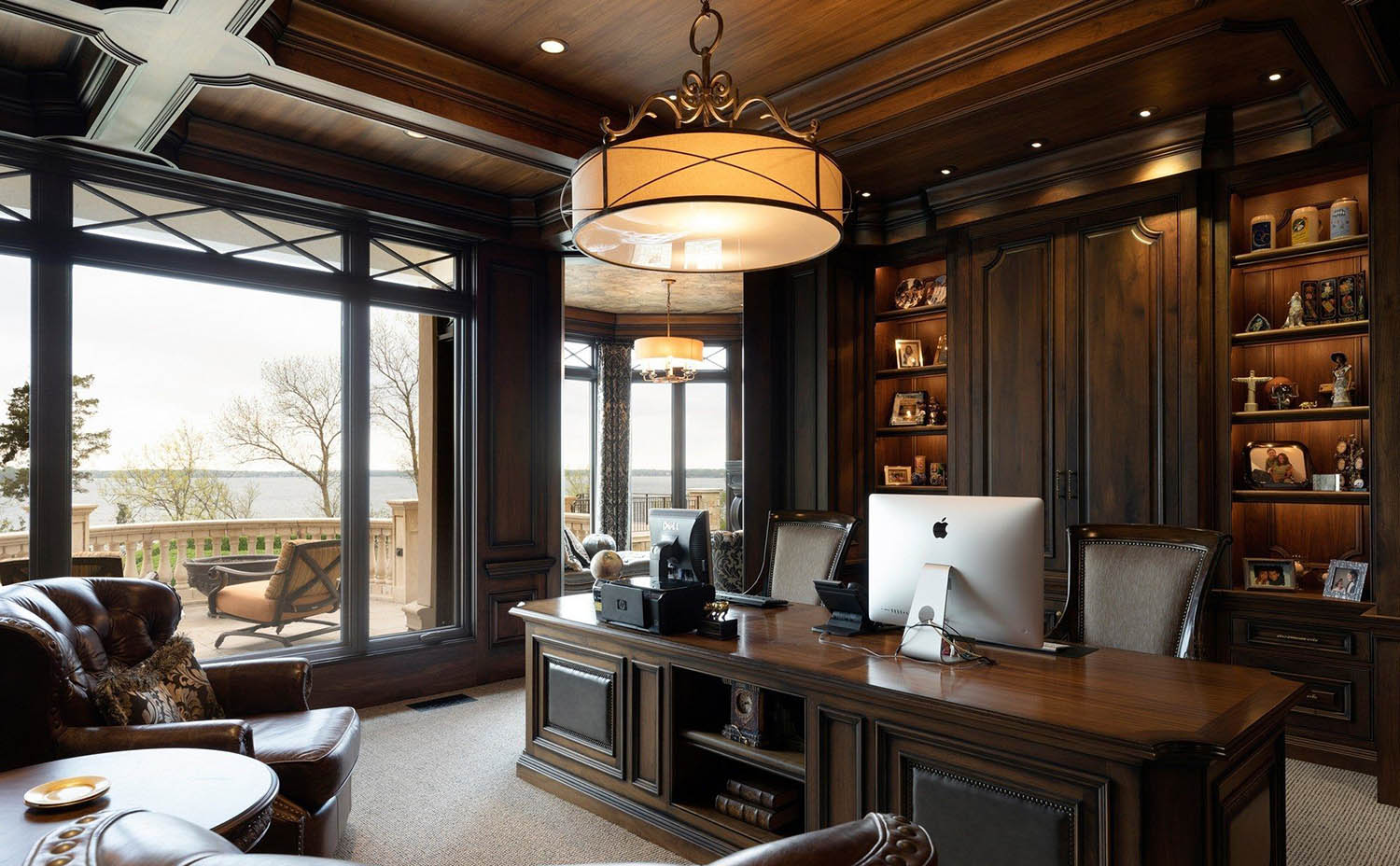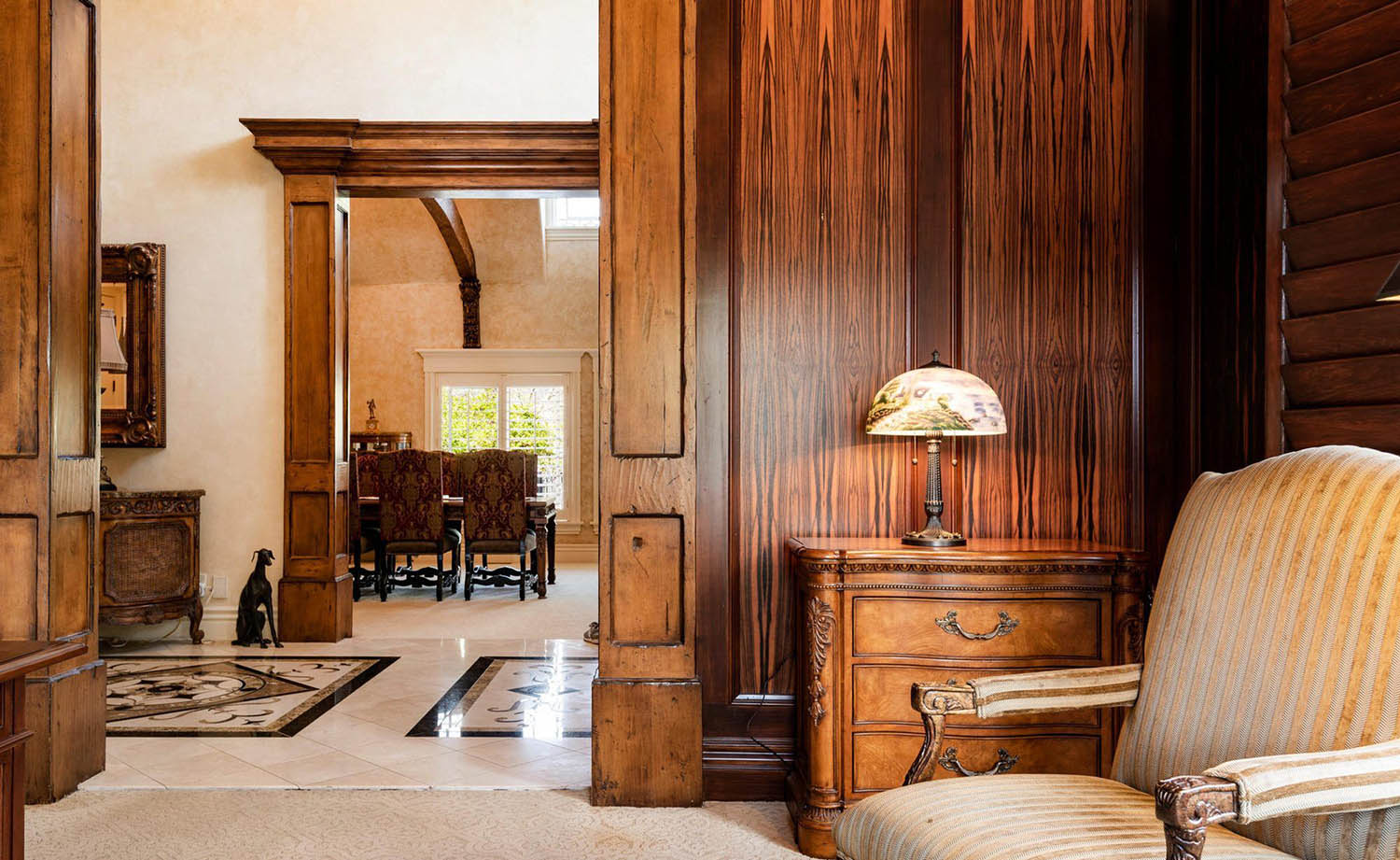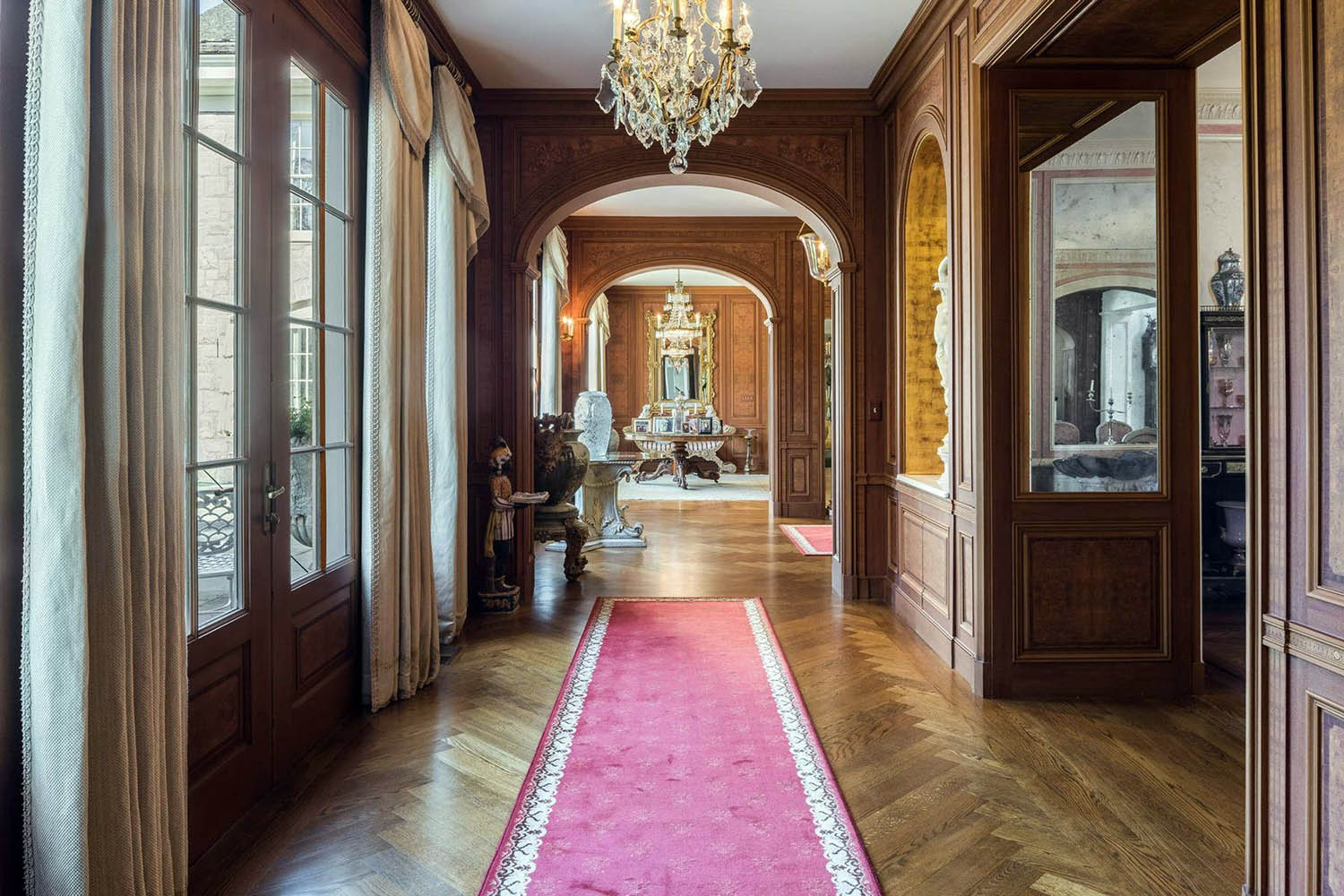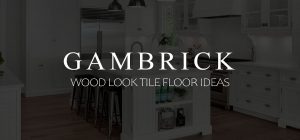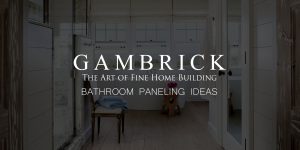How To Mix Wood Tones In Your Home
When you mix wood tones in a home, it’s very important to establish a base or dominant color first. All your other wood colors should relate to the main in terms of tone, contrast, temperature and color. Many people think you have to use the same type of wood and tone throughout the house but that’s not the case. I actually prefer using lots of species because it creates a nice style and visual contrast. However I always coordinate the stain colors back to a main wood tone and overall theme. The use of several types of wood in a home can add a lot of interest and dimension. Using the same wood tone throughout a space can make things look flat and boring. I want individual pieces to stand out while still looking good together. Go for a layered design with wood tones that both compliment and contrast.
First, choose a dominant wood tone. This is usually the largest wood object in the room or what you establish as your focal point. Wood floors are a good example along with furniture, cabinetry or wood walls. Next, find some contrast. It’s a great way to make pieces stand out. Mix a lighter wood with a darker wood. Subtle changes are typically enough to create contrast. You don’t have to go overboard with a super light tone against something really dark. An easy formula to follow is a light, medium, and dark tone.
When you mix wood tones throughout a home, try to see them as part of one overall design. They should be related but different enough so that they stand out and don’t look flat. It may seem difficult at first but it’s actually not that hard when you get the hang of it. Ahead we’ll look at how to do it in more detail with lots of tips and tricks.
Beautiful home office matching multiple wood tones throughout the room with a dark main color.
Identify Your Dominant Wood Tone
Determining your main wood tone is pretty easy. It’s typically the largest piece of wood in the house or what you want to use as the focal point.
Wood floors, cabinetry or furniture are generally the dominant color. But it can also be more unique items like a piano, some antiques or wood frames. The dominant wood tone doesn’t always mean the largest, but that’s what’s most common.
Tone refers to the temperature of your wood. Is the wood warm or cool. But there are also factors such as how dark the wood is, how much color is used in the stain, the color or the stain and of the wood. Wood tones can be seen in major finishes such as wood flooring, cabinets, furniture, frames, trim, paneling and windows.
Take a look a careful look at your room if none of these things stand out to you. If you don’t have a clear dominant color then you may have to create one.
Keep in mind how you’ll be furnishing a room before you choose the dominant color. For example, you may think it’s the wood flooring in an unfinished room. However, when you ad furniture and an area rug you may realize very little of the flooring is actually seen.
Add Contrasting Wood Tones
Next, introduce some contrast. It’s a great thing to have when designing any room or element of the house. Contrast is what makes things stand out. Without it your house can start to look flat.
When you have two types of wood in the same room, especially when right up against one another, mix a light and a dark. An easy thing to try is choosing a light, medium, and dark tone. Just keep in mind that this doesn’t mean a white, gray and black. The difference in wood tone can be very subtle. A little goes a long way when it comes to contrast. I actually prefer my wood to be very close in tone with just enough variation to be interesting.
Subtle Contrast
My favorite way to mix wood tones in a home is with subtle contrast. This can mean using the same exact stain on the same species of wood but just a little heavier. By using subtle contrast, it makes designing easier because I’m basically using the same stains only in different amounts.
I like to have at least 3 different wood tones in a room if I can get it. Light, medium and dark.
Heavy Contrast
Mixing wood tones in a room using a high contrast can be fun too. These rooms remind me of a museum with lots of thick wood frames, all stained and finished a different way. All the wood finishes are very different but also stand out. It’s an eclectic look that works really well in a room with lots of antiques. It’s meant to look random although I think it works best with some planning.
Medium Contrast
Medium levels of contrast is very similar to being subtle with just a little more variety. When I design a room like this I actually start with subtle variations and just darken a few. It makes the design easier for me to pull off. I typically stay away from anything too light or too dark. Mid toned wood stains are the easiest to pull off.
Beautiful home mixing lots of wood tones with trim, wall paneling, beams and furniture.
Warning: Wood That Doesn’t Contrast Looks Flat
Using the same wood tone throughout a room can make everything look flat. Use a layered design, with wood tones that both compliment and contrast one another.
As you decorate your home over time, it’s easy to buy individual pieces that look great at the store but not necessarily in your home. Be mindful of how something will look when you actually put it in your home. If it’s too similar to what you already have, the design can look flat.
Buying something that doesn’t necessarily match what you have is better then something that’s exactly the same. At least you’ll have some contrast and it’ll stand out. Just do your best to make it relate in some way to your dominant wood tone.
Look At Wood Undertones
Examine the undertone of the main wood tone your using to find other wood tones that go with it.
Whenever possible, examine your main wood in natural light. Warm tones or cold tones are what you’re looking for. Warm tones will be represented by yellow, orange, or red. They may be found in most unfinished woods, including walnut, white oak, red oak, and maple. Cool tones will appear to have a grey hue. Cool tones can be found in woods stained with charcoal, bark, or sand.
Next, coordinate the undertones. Most wood is naturally warm because it’s a living thing but that’s not always true. Walnut is a versatile type of wood because it’s so neutral. The undertone could be on the warm or cool side depending on the cut, type of stain and surrounding colors.
If your dominate wood tone is warm, stick with warm woods. However if your main wood has a cool tone, look for other pieces with blue/gray undertones.
You can use all light wood tones, it can create a beautiful look with a soothing vibe. But it gets harder to avoid clashes when the difference between your values is smaller.
Remember: Value is how light or dark something is, Tone is how warm or cool it is.
Also consider the colors your using throughout the room. This is something that’s often overlooked. Don’t tunnel vision on just the wood your using. If the room is painted gray with lots of cool furniture, it doesn’t make much sense using warm wood tones with a golden hue.
Stunning home mixing multiple complimentary wood tones. Wood walls, floors, furniture and trim.
Complement Or Contrast Your Wood Tones
Once you’ve chosen whether your primary wood tone is cold or warm, you can either compliment or contrast it with your other wood tones.
Compliment Your Wood Tones
Compliment all your wood tones by sticking within the same family. This gives your home’s wood a cohesive aesthetic. Colors that complement each other look great together, but aren’t too similar. It also makes a design look more thought out and less random.
Complimentary wood tones are the most common way to mix wood tones throughout a home.
Contrast Your Wood Tones
Choose the opposite of your undertone to create something very different. The goal here is to contrast your dominant wood’s tone. Don’t choose a wood that’s just slightly different. Go for high contrast. This works great for accent or trim pieces that you want to really stand out. It’s also a nice touch for large focal points like a piano or antique.
Another great thing about using this technique is that it’s the opposite of playing it safe and most designers don’t even try it. I wouldn’t recommend designing an entire home this way, but using in a room or two for some special pieces looks great.
For example, the desk in my office is an antique that contrasts all the other wood tones throughout the room. The walls, ceiling and floors are all wood and compliment each other so another similar wood tone would look flat. By using contrast the desk really stands out when you enter the room. I wanted the desk to really pop against the rest o the wood and using high contrast gave me the exact effect I wanted.
Use Each Wood Multiple Times
Use each wood at least twice. This helps to add some structure to your wood tone design. It also offers some coherence and helps prevent things from looking out of place or too random. Even if they’re small pieces of furniture or accessories, using the same wood tone more than once reinforces the choice you made.
Part of what makes a home’s design feel deliberate and well thought out is repetition. Professional designs use this concept all the time. They feel connected and less random because they use the same design concepts throughout the room in repetition. Using the same color, texture, style or in this case wood tone multiple times helps reinforce the look.
When mixing wood tones, try to represent each tone at least twice somewhere in the room. The wood piece could be as small as a bowl or frame. It doesn’t have to be huge. A great trick I like to use is pairing a large piece of furniture with something very small like a carving or pot.
Balance the wood tones you use as much as possible. Avoid clustering all of your wood in one small area. Spread them out and use wood throughout the room. Keep in mind that the eye can see lots of color and texture in it’s field of vision beyond just what your looking at.
Frames are a great place to tie in a wood tone the the rest of the room. If you have a piece of wood furniture with a tone you want to re-use somewhere in the room, try a frame.
Don’t Forget The Wood Grain
Wood grain is a feature that’s often overlooked when matching wood tones. It stains a different color than the rest of the wood and has a look that’s unique to it’s species. When most people consider matching wood tones in a house they’re usually looking at the main color of the wood and not the grain. But grain can sometimes be just as important depending on how prominent it is. Some species are know and chosen just for the grain so keep this in mind.
A beautiful, rich grain can be a great thing.
Large, deep wood grains make a home feel rustic and raw, while subtle wood grains make the room feel formal and modern. Try using a little bit of both. You can play with wood grain to add contrast just like you can with tone, color, texture and style.
Large wood grain paired with small grains can be a great effect. Typically wood with a deep grain stains a different color than wood with subtle grain so it can make your work a bit harder, but worth the effort.
Use reclaimed wood and rough edges as accent pieces with a story to tell. They can help tie a room together and unite different wood tones together. I love sprinkling in a re-claimed beam or two or using a raw slice of timber as a table top.
One of the things I hate about many designs is the lack of natural elements like wood grain. Don’t be afraid to use it in it’s natural state. Real wood can be a very beautiful part of a home’s design.
Consider A Bridge Color
Adding a bridge color is a great way to go from a really dark to a really light wood tone.
The bridge color will be a medium-toned wood that sits in between your light and dark wood. It produces an appealing overall aesthetic by connecting two colors that are far apart like a white and black. Think of it as softening the transition between two colors.
Add Neutral Colors
If your wood tones need to be broken up, consider adding some furniture in a neutral hue.Mixing wood tones in a home isn’t all about the wood, but also the overall colors you use throughout the home. Neutrals go with the most colors so it makes matching woods easier. Bright and bold colors makes matching wood tones a little harder because you also have to match those other color choices too.
Keeping your wood tones in the gray family is a terrific approach. It creates some balance and makes it easier to coordinate with other colors. This is a great option if your using lots of bright, bold colors because gray woods are your neutral. They’ll be easier to match with other wood tones and colors.
Finishing touches can help to bring the entire design together. Consider using some white or metallic finishes to work with the wood.
Use Textiles Where Needed
Adding textiles to the design is a simple trick that makes a great impact in a home using lots of wood tones.Have you ever seen older style homes with wood walls, floors, ceilings and furniture? The best ones also used textiles and drapery to add color and some additional visual interest through patterns. Try it in your own home if your using lots of complimentary wood colors.
Textiles can be a terrific way to pull together different woods. They help create a more complete design. Rugs, cushions, and window coverings can all be used to connect various woods together. Rugs, in particular, may serve as excellent buffers between different wood tones. I love using area rugs in almost all my designs. They’re so easy to lay and have a big impact. And I like how easy they are to change whenever I want to change my look a little.
A rug doesn’t have to match the wood tones. In fact, I like to use rugs as a way to bring in more contrast. They let me be more playful with patterns and colors I wouldn’t ordinarily use. But there are some decisions you’ll have to make. Do you want the rugs colors to be complimentary to your wood tones are contrast them? Both work great.
Balance The Wood Tones
Mixing wood tones throughout your home successfully is about balance. Each new tone you use has to both look great on it’s own but also work within the overall design and flow of the room. That’s why it’s so important to connect your new wood tones to the main color. It helps create the balance you need.
If you don’t tie the pieces together your room can look a little disjointed. However this can sometimes work if it’s an accent piece you really want noticed or a focal point.
Use the same wood tone more than once in the room to create more balance. Just don’t use them right next to each other. Balancing out a room works better if colors are used further apart.It helps tie the room together.
Don’t Overdo It
Wood is making a big comeback these days. So there are more wood tones, cabinets, and accessories to choose from than ever before.
With so many choices it gets easier to overdo things. If you feel like your overdoing the wood tones then pull back a bit. Start with the dominant wood tone and move out from there piece by piece. Always reference back to the main tone, try to use each tone at least twice, and use contrast. Remember to relate all your choice to a main theme.
You can do it and it’s worth the effort.
Summary: How To Mix Wood Tones In Your Home
When you mix wood tones in a home, it’s very important to establish a base or dominant color first. All your other wood colors should relate to the main in terms of tone, contrast, temperature and color. Many people think you have to use the same type of wood and tone throughout the house but that’s not the case. I actually prefer using lots of species because it creates a nice style and visual contrast. However I always coordinate the stain colors back to a main wood tone and overall theme. The use of several types of wood in a home can add a lot of interest and dimension. Using the same wood tone throughout a space can make things look flat and boring. I want individual pieces to stand out while still looking good together. Go for a layered design with wood tones that both compliment and contrast.
First, choose a dominant wood tone. This is usually the largest wood object in the room or what you establish as your focal point. Wood floors are a good example along with furniture, cabinetry or wood walls. Next, find some contrast. It’s a great way to make pieces stand out. Mix a lighter wood with a darker wood. Subtle changes are typically enough to create contrast. You don’t have to go overboard with a super light tone against something really dark. An easy formula to follow is a light, medium, and dark tone.
When you mix wood tones throughout a home, try to see them as part of one overall design. They should be related but different enough so that they stand out and don’t look flat. It may seem difficult at first but it’s actually not that hard when you get the hang of it.
If you have any questions or comments about mixing wood tones E-mail any time.

